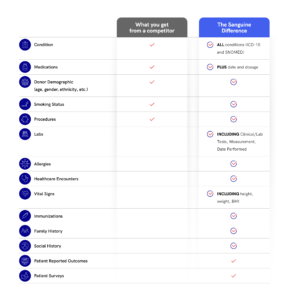Sanguine Connections: Electronic Health Records (EHR) an essential with your biospecimens
Welcome to Sanguine Connections exploring the process, challenges, and nuances of biospecimen procurement for translational studies.

Electronic Health Records (EHR) an essential with your biospecimens
In this edition, we explore electronic health records (EHR) – what they are and the benefits including more information and faster.
EHR eases exchange of information
In 2016, Congress passed the 21st Century Cures Act which includes provisions to empower people with greater control over their health information including access to EHR. Beyond, access to EHR for patients is to promote interoperability – meaning exchange of data across healthcare systems while protecting privacy and compliance. These enhancements streamline the ability to see (and share with our healthcare providers) medical history, lab results, immunizations, etc. across healthcare providers. The ease of exchange of information extends to people wanting to participate in medical research as the time it takes for retrieving medical records goes from weeks down to minutes making the ability to participate much faster. Increased speed in retrieval means shortened time for biospecimen collection for research studies.
Increased information and confidence with EHR for researchers
Many translational studies rely on the findings from using donor biospecimens. These invaluable resources can be so much more than just what is in the tube as there are significant amounts of data associated with the biospecimen. First, a confirmed diagnosis is crucial for confidence the sample is what you are expecting. Second, the amount of historical information about medications and lab results helps significantly in identifying and qualifying the best individuals for a specific study. Further, additional information such as vital signs, social history, immunization history, and family history may serve as supplementary data for researchers when interpreting results.
The standardized structure of the EHR data, whether as consolidated clinical document architecture (CCDA) or fast healthcare interoperability resource (FHIR),makes accessing the relevant information fast and easy to incorporate into a secure, compliant software.
Brian Neman, the CEO and co-founder of Sanguine describes the investment in integration of EHR with biospecimen collection, “The need for more comprehensive datasets, including both molecular and clinical data, continues to grow, driven by drug developers’ needs in biomarker discovery, but also more recently in cell and gene therapy. The industry is accumulating more and more evidence that for purposes of these next-generation advanced therapies, that increased information on the cells used, either in research or in manufacturing , is necessary for successful outcomes.”
EHR provides the confidence in the sample fitting your research needs including diagnosed condition and other inclusion and exclusion (I/E) criteria, as well as significantly more data about the history of health of the donor. The additional depth of information EHR provides alongside biospecimen collections will continue to add value in facilitating discovery as the data itself can provide significant information for discovery, supporting clinical claims, and essential for robust population studies.
Learn more about the Sanguine Difference.
By: Eliza Small, Ph.D.
Director Content Marketing at Sanguine
